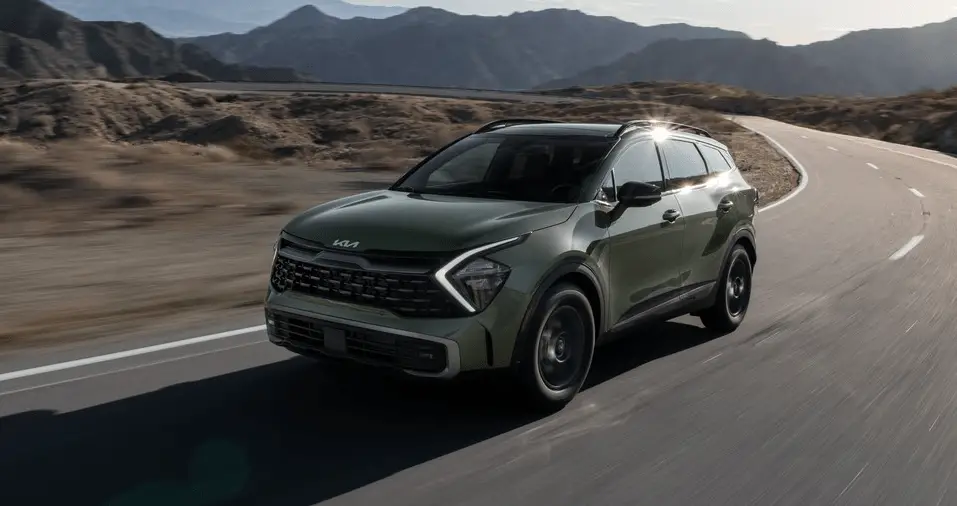 Kia Sportage 2023 Navigation-Based Smart Cruise Control (NSCC) and Lane Following Assist (LFA)
Kia Sportage 2023 Navigation-Based Smart Cruise Control (NSCC) and Lane Following Assist (LFA)
In the world of constantly improving cars, the 2023 Kia Sportage brings together a powerful pair that perfectly combines technology and driver-centric design: Lane Following Assist (LFA) and Navigation-Based Smart Cruise Control (NBSCC). NBSCC is a big step forward in adaptive cruise control. It uses GPS and navigation data to predict what the road ahead will be like, automatically adjusting the speed of the car to handle curves, intersections, and changes in the speed limit with unmatched accuracy and foresight. It starts a new era of smooth and effective speed control and shows that Kia is committed to making driving better. LFA, a guardian of lane discipline driven by advanced cameras and sensors that constantly check lane markings, goes well with this technological marvel. It not only finds the car in its lane, but it also actively helps keep it there, which boosts both safety and driver confidence.
In the 2023 Kia Sportage, NBSCC and LFA are more than just features; they represent a future where every drive is a perfect mix of new technology and driver freedom, bringing a new era of great cars.
2023 KIA SPORTAGE Specs, Price, Features and Mileage (Brochure)
Navigation-based Smart Cruise Control (NSCC)
Navigation-based Smart Cruise Control will help automatically adjust vehicle speed when driving on highways (or motorways) by using road information from the navigation function while Smart Cruise Control is operating.
NOTICE
Navigation-based Smart Cruise Control is available only on controlled access road of certain highways
Controlled access road indicates roads with limited entrances and exits that allow uninterrupted high-speed traffic flow. Only passenger cars and motorcycles are allowed on controlled access roads.
| Available highway (Controlled access road) | |
| USA | Select Interstate Highway and U.S. (Federal) and
State Highways |
| Canada | Select Provincial and Territorial Highways |
- Additional highways may be expanded by future navigation updates.
NOTICE
Navigation-based Smart Cruise Control operates on main roads of highways (or motorways), and does not operate on interchanges or junctions.
WARNING
Navigation-based Smart Cruise Control is a supplemental system and is not a substitute for safe driving. It is the responsibility of the driver to always check the speed and distance to the vehicle ahead. Always drive safely and use caution.
Highway Curve Zone Auto Slow-down
If vehicle speed is high, the Highway Curve Zone Auto Slowdown function will temporarily decelerate your vehicle or limit acceleration to help you drive safely on a curve based on the curve information from the navigation.
Highway Set Speed Auto Change
Highway Set Speed Auto Change function automatically changes Smart Cruise Control set speed based on the speed limit information from the navigation.
Navigation-based Smart Cruise Control settings
Setting features

A: Driver Assistance
- Driving Convenience
- Highway Auto Speed Change
With the vehicle on, select Settings→ Driver Assistance → Driving Convenience → Highway Auto Speed Change from the User settings menu or select Settings→ Vehicle → Driver Assistance → Driving Convenience → Highway Auto Speed Change from the infotainment system screen to turn on Navigation-based Smart Cruise Control and deselect to turn off the function.
NOTICE
When there is a problem with Navigation-based Smart Cruise Control, the function cannot be set from the Settings menu.
Navigation-based Smart Cruise Control operation
Operating conditions
Navigation-based Smart Cruise Control is ready to operate if all of the following conditions are satisfied:
- Smart Cruise Control is operating
- Driving on main roads of highways (or motorways)
WARNING
Navigation-based Smart Cruise Control (NSCC) is a supplemental system and is not a substitute for safe driving. It is the responsibility of the driver to always check the speed and distance to the vehicle ahead. Always drive safely and use caution.
Navigation-based Smart Cruise Control display and control
When Navigation-based Smart Cruise Control operates, it will be displayed on the cluster as follows:
Navigation-based Smart Cruise Control standby
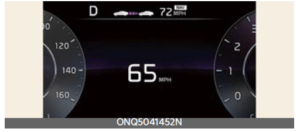
If the operating conditions are satisfied, the white ( ) symbol will appear.
Navigation-based Smart Cruise Control operating

If temporary deceleration is required in the standby state and Navigation-based Smart Cruise Control is operating, the green ( ) symbol will appear on the cluster.
If the Highway Set Speed Auto Change function operates, the green ( ) symbol and set speed will appear on the cluster, and an audible warning will sound.
WARNING
The warning message will appear in the following circumstances:
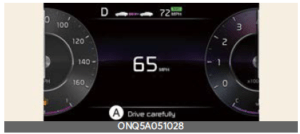
A: Drive carefully
- Navigation-based Smart Cruise Control is not able to slow down your vehicle to a safe speed.
NOTICE
- The Highway Curve Zone Auto Slowdown and Set Speed Auto Change function uses the same ( ) symbol.
- The images or colours may be displayed differently depending on the specifications of the instrument cluster or theme.
Highway Curve Zone Auto Slow-down
Depending on the curve ahead on the highway (or motorway), the vehicle will decelerate, and after passing the curve, the vehicle will accelerate to Smart Cruise Control set speed.
NOTICE
Vehicle deceleration time may differ depending on the vehicle speed and the degree of the curve on the road. The higher the driving speed, deceleration will start faster.
Highway Set Speed Auto Change
The Highway Set Speed Auto Change function will operate when Smart Cruise Control set speed and the highway (or motorway) speed limit is matched.
While the Highway Set Speed Auto Change function is operating, when the highway (or motorway), speed limit changes, Smart Cruise Control set speed automatically changes to the changed speed limit.
- If the Highway Set Speed Auto Change function has changed to the standby state by driving on a road other than the highway (or motorway) main road, Highway Set Speed Auto Change function will operate again when you drive on the main road again without setting the set speed.
- If the Highway Set Speed Auto Change function has changed to the standby state by depressing the brake pedal, press the ( ) switch to restart the function.
NOTICE
- If the Smart Cruise Control set speed is adjusted differently from the speed limit, the Highway Set Speed Auto Change function will be in the standby state.
- The Highway Set Speed Auto Change function only operates based on the speed limits of the highway (or motorway), it does not work with the speed cameras.
- When the Highway Set Speed Auto Change function is operating, the vehicle automatically accelerates or decelerates when the highway (or motorway) speed limit changes.
- The maximum set speed for the Highway Set Speed Auto Change function is 90 mph (140 km/h).
- If the speed limit of a new road is not updated in the navigation, the Highway Set Speed Auto Change function may not operate properly.
- If the speed unit is set to a unit other than the speed unit used in your country, the Highway Set Speed Auto Change function may not operate properly.
- When the Highway Set Speed Auto Change function is operating, the vehicle may warn the driver when the vehicle’s set speed limit is above the speed camera limit.
- The Highway Set Speed Auto Change function does not operate on highway interchanges or junctions.
Navigation-based Smart Cruise Control limitations
Navigation-based Smart Cruise Control may not operate normally under the following circumstances:
- The navigation is not working properly
- Map information is not transmitted due to the infotainment system’s abnormal operation
- Speed limit and road information in the navigation is not updated
- The map information and the actual road is different because of real-time GPS data or map information error
- The navigation searches for a route while driving
- GPS signals are blocked in areas such as tunnel
- A road that divides into two or more roads and joins again
- The driver goes off course the route set in the navigation
- The route to the destination is changed or cancelled by resetting the navigation
- The vehicle enters a service station or rest area
- Android Auto or Car Play is operating
- The navigation cannot detect the current vehicle position (ex: elevated roads including overpasses adjacent to general roads or nearby roads exist in a parallel way)
- The navigation is being updated while driving
- The navigation is being restarted while driving
- The speed limit of some sections changes according to the road situations
- Driving on a road under construction
- Driving on a road that is controlled
- There is bad weather, such as heavy rain, heavy snow, etc.
- Driving on a road that is sharply curved
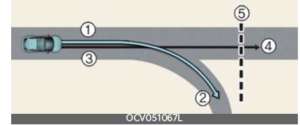
[1]: Set route, [2]: Branch line, [3]: Driving route, [4]: Main road, [5]: Curved road section
- When there is a difference between the navigation set route (branch line) and the driving route (main road), the Highway Curve Zone Auto Slowdown function may not operate until the driving route is recognized as the main road.
- When the vehicle’s driving route is recognized as the main road by maintaining the main road instead of the navigation set route, the Highway Curve Zone Auto Slowdown function will operate. Depending on the distance to the curve and the current vehicle speed, vehicle deceleration may not be sufficient or may decelerate rapidly.

[1]: Main road, [2]: Branch line, [3]: Driving route, [4]: Set route, [5]: Curved road section
- When there is a difference between the navigation route (main road) and the driving route (branch line), High-way Curve Zone Auto Slowdown function will operate temporarily based on the curve information on the main road.
- When it is judged that you are driving out of the route by entering the high-way interchange or junction, Highway Curve Zone Auto Slowdown function will not operate.
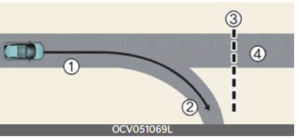
[1]: Driving route, [2]: Branch line, [3]: Curved road section, [4]: Main road
- If there is no destination set on the navigation, the Highway Curve Zone Auto Slowdown function will operate based on the curve information on the main road.
- Even if you depart from the main road, the Highway Curve Zone Auto Slow-down function may temporarily operate due to navigation information of the highway curve section.
WARNING
- Navigation-based Smart Cruise Control is not a substitute for safe driving practices, but a convenience function. Always have your eyes on the road, and it is the responsibility of the driver to avoid violating traffic laws.
- The navigation’s speed limit information may differ from the actual speed limit information on the road. It is the driver’s responsibility to check the speed limit on the actual driving road or lane.
- Navigation-based Smart Cruise Control will automatically be cancelled when you leave the highway (or motorway) main road. Always pay attention to road and driving conditions while driving.
- Navigation-based Smart Cruise Control may not operate due to the existence of leading vehicles and the driving conditions of the vehicle. Always pay attention to road and driving conditions while driving.
- When you are towing a trailer or another vehicle, we recommend that Navigation-based Smart Cruise Control is turned off due to safety reasons.
- After you pass through a tollgate on a highway (or motorway), Navigation-based Smart Cruise Control will operate based on the first lane. If you enter one of the other lanes, the function might not operate properly.
- The vehicle will accelerate if the driver depresses the accelerator pedal while Navigation-based Smart Cruise Control is operating, and the function will not decelerate the vehicle. However, if the accelerator pedal is depressed insufficiently, the vehicle may decelerate.
- If the driver accelerates and releases the accelerator pedal while Navigation-based Smart Cruise Control is operating, the vehicle may not decelerate sufficiently or may rapidly decelerate to a safe speed.
- If the curve is too large or too small, Navigation-based Smart Cruise Control may not operate.
NOTICE
- The speed information on the cluster and navigation may differ.
- A time gap could occur between the navigation’s guidance and when the Navigation-based Smart Cruise Con-trol operation starts and ends.
- Even if you are driving at a speed lower than Smart Cruise Control’s set speed, acceleration may be limited by the curve sections ahead.
- If Navigation-based Smart Cruise Control is operating while leaving the main road to enter an interchange, junction, rest area, etc., the function may operate for a certain period of time.
- Deceleration by Navigation-based Smart Cruise Control may feel it is not sufficient due to road conditions such as uneven road surfaces, narrow lanes, etc.
This device complies with Part 15 of the FCC rules.
Operation is subject to the following three conditions:
- This device may not cause harmful interference, and
- This device must accept any interference received, including interference that may cause undesired operation.
- Changes or modifications not expressly approved by the party responsible for compliance could void the user’s authority to operate the device.
Radiofrequency radiation exposure information:
This equipment complies with FCC radiation exposure limits set forth for an uncontrolled environment. This equipment should be installed and operated with a minimum distance of 8 inches (20 cm) between the radiator (antenna) and your body. This transmitter must not be collocated or operating in conjunction with any other antenna or transmitter.
Lane Following Assist (LFA)
Lane Following Assist is designed to help detect lane markings and/or vehicles on the road, and assists the driver’s steering to help keep the vehicle between lanes.
Detecting sensor
Front view camera
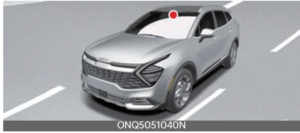 The front view camera is used as a detecting sensor to detect lane markings and front vehicles.
The front view camera is used as a detecting sensor to detect lane markings and front vehicles.
Refer to the picture above for the detailed location of the detecting sensor.
Lane Following Assist settings
Turning Lane Following Assist On/Off

With the vehicle on, press the Lane Driving Assist button located on the steering wheel to turn on Lane Following Assist. The gray or green ( ) indicator light will appear on the cluster.
Press the button again to turn off the function.
Warning Volume

A: Driver Assistance
- Warning Volume
- High
- Medium
- Low
With the vehicle on, select Settings→ Vehicle → Driver Assistance → Warning Volume from the User Settings menu or select Settings→ Vehicle → Driver Assistance → Warning Volume from the infotainment system to change the Warning Volume to High,
Medium or Low.
NOTICE
If you change the Warning Volume, the warning volume of other Driver Assistance systems may change.
Lane Following Assist operation
Lane Following Assist will control and warn the vehicle by ‘Lane Following Assist’ and ‘Hands-off warning’.
Lane Following Assist

If the vehicle ahead and/or both lane markings are detected and your vehicle speed is below 110 mph (180 km/h), Lane Following Assist will help center the vehicle in the lane by assisting the steering wheel. The green ( ) indicator light will appear on the cluster.
CAUTION
When the steering wheel is not assisted, the white ( ) indicator light will blink and change to grey.
Hands-off warning
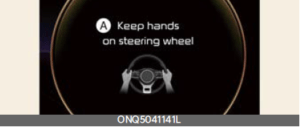
A: Keep hands on the steering wheel
If the driver takes their hands off the steering wheel for several seconds, the warning message will appear and an audible warning will sound in stages.
- First stage: Warning message
- Second stage: Warning message (red steering wheel) and audible warning
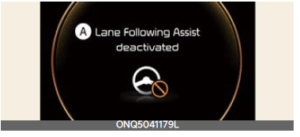
A: Lane Following Assist deactivated
If the driver still does not have their hands on the steering wheel after the hands-off warning, the warning message will appear and Lane Following Assist will be automatically canceled.
WARNING
- The steering wheel may not be assisted if the steering wheel is held very tight or the steering wheel is steered over a certain degree.
- Lane Following Assist does not operate at all times. It is the responsibility of the driver to safely steer the vehicle and to maintain the vehicle in its lane.
- The hands–off warning message may appear late depending on road conditions. Always have your hands on the steering wheel while driving.
- If the steering wheel is held very lightly the hands–off warning message may appear because Lane Following Assist may not detect that the driver has their hands on the steering wheel.
- If you attach objects to the steering wheel, the hands-off warning may not work properly.
NOTICE
- For more details on setting Lane Following Assist in the infotainment system, refer to the Navigation Quick Reference Guide.
- When both lane markings are detected, the lane lines on the cluster will change from grey to white.
Lane undetected
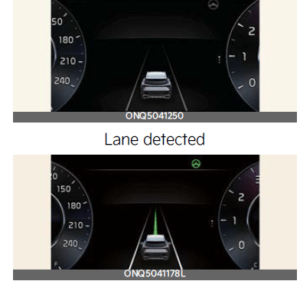
- The images and colors in the cluster may differ depending on the cluster type or theme selected from the cluster.
- If lane markings are not detected, steering wheel control by Lane Following Assist can be limited depending on whether a vehicle is in front or the driving conditions of the vehicle.
- Even though the steering is assisted by Lane Following Assist, the driver may control the steering wheel.
- The steering wheel may feel heavier or lighter when the steering wheel is assisted by Lane Following Assist than when it is not.
Lane Following Assist malfunction and limitations
Lane Following Assist malfunction
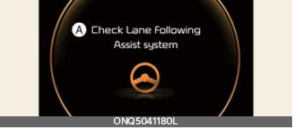
A: Check Lane Following Assist system
When Lane Following Assist is not working properly, the warning message will appear and the master warning light ( ) will appear on the cluster. If this occurs, have Lane Following Assist inspected by an authorized Kia dealer.
FAQ
Navigation-Based Smart Cruise Control is an advanced adaptive cruise control system that uses GPS and navigation data to adjust the vehicle’s speed based on the upcoming road and traffic conditions.
NBSCC uses GPS data and map information to anticipate curves, junctions, and speed limit changes on the road ahead. It can automatically adjust the vehicle’s speed to ensure a smoother and more efficient cruise control experience.
NBSCC is typically a feature that can be turned on or off by the driver through vehicle settings, allowing the driver to choose when to use it.
Yes, the driver can typically manually override NBSCC by using the accelerator or brake pedal or by deactivating the system through the vehicle’s controls.
NBSCC is designed for use on highways and well-marked roads where navigation data is available. It may not be as effective on unmarked or poorly marked roads.
Yes, NBSCC can often be used in conjunction with other driver assistance features such as Lane Keeping Assist and Blind-Spot Collision-Avoidance Assist.
NBSCC is designed to require minimal maintenance. Regularly updating the vehicle’s navigation system and software is recommended to ensure its functionality.
NBSCC is typically integrated with Kia’s navigation system, and its effectiveness may depend on the accuracy and quality of the navigation data.
Lane Following Assist is a driver assistance feature that helps keep the vehicle centered within its lane by providing steering inputs.
LFA typically uses cameras and sensors to detect lane markings on the road. It can provide gentle steering assistance to help the driver keep the vehicle in the center of the lane.
LFA is usually a feature that can be turned on or off by the driver through vehicle settings.
LFA typically works at a range of speeds, covering both low-speed city driving and highway speeds.
Depending on the model and trim level, some Kia Sportage models may allow drivers to adjust the sensitivity or activation threshold of the LFA system through vehicle settings.
Yes, LFA can often be used in conjunction with other driver assistance features such as Adaptive Cruise Control and Blind-Spot Collision-Avoidance Assist.
LFA can be effective in helping drivers stay within their lane, especially on highways and well-marked roads. However, its effectiveness may vary depending on road conditions, weather, and driver behavior, so drivers should always drive responsibly and maintain control of the vehicle.
Useful Link
View Full User Guide: Kia Sportage 2023 User Guide
Download Manuals: https://owners.kia.com/content/owners/en/manuals.html
2023 KIA SPORTAGE Specs, Price, Features and Mileage (Brochure)

